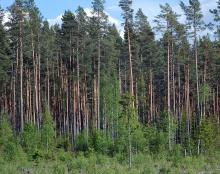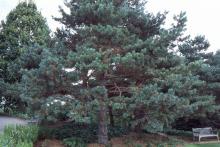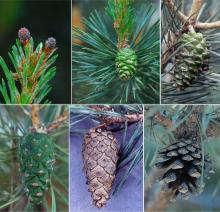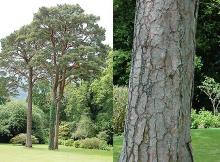Pinus sylvestris
Common name:
Scots Pine
Scotch Pine
Pronunciation:
PI-nus sil-VES-tris
Family:
Pinaceae
Genus:
Type:
Conifer
Native to (or naturalized in) Oregon:
No
- Conifer, evergreen tree, 30-60 ft (9-18 m), irregular, pyramidal in youth, branches spreading, lower ones soon dying; with age becoming wide spreading, flat-topped or rounded. Bark is orangish or orange-brown in upper branches, flaky. Needles blue-green, 2 per bundle, 2.5-8 cm long, stiff, twisted, well defined lines of stomatal on the outer side, persistent bundle sheath about 6 mm long. Cones often asymmetrical, 2.5-7 cm long (similar to leaves), with a short stalk.
- Sun. Grows on a variety of soils, including poor and dry, if well-drained. Prefers acid soils.
- Hardy to USDA Zone 2 Widely distributed, from Norway and Scotland (the only native pine of the UK) to Spain and western Asia and northeastern Siberia. There is great variability in the species and a large number of geographical varieties. Naturalized in some parts of New England.
- One of the first pine species to be introduced to North America, and it has since has become naturalized in some parts of New England. According to Farrar (1995), it is a tall straight tree in Europe with wood of excellent quality. However, in North America it is seldom straight and the wood is of poor quality. This difference is attributed to the poor seed sources used by early settlers.
-
Many cultivars are available (some 50 are listed in the catalog of an Oregon conifer nursery), the selected forms include:
-
Dwarf or slow growing
- ‘Albyn’ - a mat-like shrub to about 15 inches (40 cm) high.
- ‘Glauca Nana’ - semi-dwarf round globe, leaves coarse blue, grows about 6 inches (15 cm) per years.
- ‘Nana’ - to about 20 inches (50 cm) high, densely branched, short twigs directed up, needles 3 cm long, blue-green.
- ‘Watereri’ - growing to 10-12 ft (3-4 m) high, nearly as wide, branch tips directed upward, needles 2.5-4 cm long, blue-green. Discovered in 1865.
- ‘Hillside Creeper’ - low growing creeping form, branches more or less horizontal, to 2 ft (0.6 m) high and 6 ft (1.8 m) wide.
-
Upright
- ‘Fastigiata’ - strict, columnar habit, to 50 ft (15 m) high, stiff upright branches, may become "untidy and bare" with age, some consider ‘Fastigiata Drath’ an improved upright form.
- ‘Globosa Viridis’ - reportedly a "dwarf gobose globe" but it resembles a Dwarf Alberta Spruce (e.g., ‘Conica’).
-
Variegated
- ‘Aurea’ - needles bright gold in winter, may look sickly in summer, upright loose tree unless pruned, growing about 1 ft (30 cm) per year.
- ‘Gold Coin’ - foliage golden-yellow in winter, dull yellow in summer, upright habit, grows 8-12 inches (20-30 cm) per year.
- 'Nisbet's Gold' - bright golden yellow in winter, yellow green in summer, to 6 ft (~ 2 m) in 10 years
-
Weeping
- ‘Pendula’ - branches distinctly pendulous, basal branches lying on the ground.
-
Dwarf or slow growing
- sylvestris: of the woods














